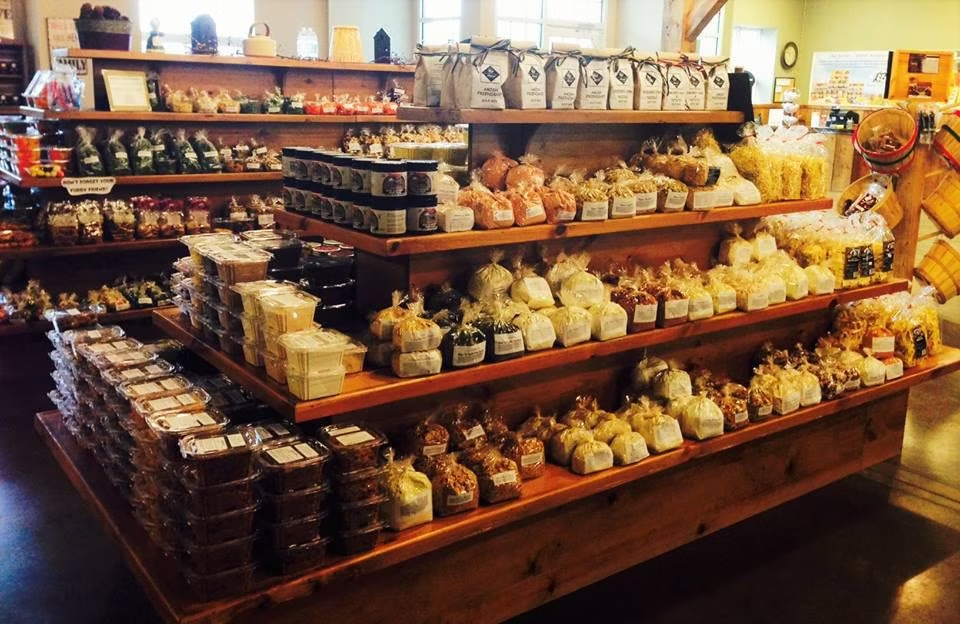Discovering the Culinary Gems: A Guide to Ohio’s Amish Country Food Markets
Ohio’s Amish Country is a captivating destination that offers much more than just scenic landscapes and charming communities. It’s a culinary paradise where food markets and bakeries beckon visitors with the irresistible aromas of freshly baked goods and locally sourced delicacies. These markets are a treasure trove of authentic Amish cuisine, handcrafted goods, and a glimpse into the rich cultural heritage of the region.
As you embark on your journey through Amish Country, prepare to be enchanted by the warm hospitality and the mouthwatering flavors that await you. From bustling indoor markets to quaint roadside stands, each stop promises a unique and unforgettable experience.
The Aroma of Freshly Baked Delights
One of the highlights of any visit to Amish Country is the opportunity to indulge in the delectable baked goods that have become synonymous with the region. Step into Yoder’s Bakery and Furniture (2621 Burnt Cabin Road, Seaman, OH; 937-386-9995), and you’ll be greeted by the heavenly scent of warm cinnamon rolls, buttery pies, and perfectly crafted breads. This Amish-owned and operated business is a true gem, offering not only mouthwatering baked treats but also handcrafted indoor and outdoor furniture, playhouses, and more.
As you wander through the markets, be sure to sample the iconic shoofly pie, a molasses-based treat that has been a staple in Amish kitchens for generations. Or perhaps you’ll be tempted by the pillowy softness of whoopie pies, those delightful cookie sandwiches filled with creamy frosting, available at places like Walnut Creek Cheeses (2641 State Route 39, Walnut Creek, OH; 330-852-2888), where you’ll find locally made foods and goods by Amish and Mennonite vendors.
Farm-Fresh Produce and Artisanal Delights
Beyond the baked goods, Amish Country food markets offer a cornucopia of farm-fresh produce, artisanal cheeses, and savory meats that celebrate the region’s agricultural heritage. Stroll through the vibrant outdoor markets like Friendly Meadows Country Store (30341A Coshocton Rd, Walhonding, OH; 740-427-2255), where you’ll find a variety of Amish groceries, including bulk foods, cheeses, and dairy products.
Explore the cheese counters at places like Meyers Specialty Market (83 E. Main St, Mcconnelsville, OH; 740-962-2803), an Amish bulk food store and health food store offering Dutch Valley Foods & Walnut Creek Foods, a meat & cheese deli, panini shop, and artisan bread bakery. And don’t miss the opportunity to sample the smoked meats, cured to perfection using time-honored techniques and infused with the rich flavors of hickory and applewood smoke.
Ohio’s Amish Country is a true haven for food enthusiasts, offering a delightful array of bakeries and markets that celebrate the region’s rich culinary heritage. From the moment you step into these charming establishments, the tantalizing aromas of freshly baked goods and locally sourced ingredients beckon you to embark on a culinary adventure like no other.
One such gem is Hershberger’s Farm & Bakery, a sweet-tooth-friendly spot that promises to satisfy your cravings for delectable treats. As you approach the bakery, you’ll be greeted by a vibrant display of fresh-picked fruits and vegetables, neatly arranged in baskets alongside a peddler cart stacked high with Ohio’s famous sweet corn.
Step inside, and you’ll be transported to a world of baked delights crafted by skilled Amish bakers. The star of the show here is undoubtedly the fry pie, a beloved local specialty. “Our most popular baked good is the fry pie,” explains manager Steven Hershberger, a third-generation family member. “It’s a foldover that has a fruit filling, and then we fry it like a doughnut and it comes with a glaze.”
Hershberger recommends trying the cherry or apple-filled fry pies, but the temptation doesn’t stop there. Vanilla-iced creamsticks and peanut butter cookies vie for your attention, alongside a vast selection of homemade jellies, rolls of butter, old-fashioned apple cider, and Amish cheeses.
After indulging in the bakery’s delights, visitors can take a break in the outdoor picnic area or embark on a delightful adventure at the on-site petting zoo. Here, you’ll have the opportunity to meet and interact with a variety of farm animals, from pot-belly pigs and miniature cows to alpacas and Nubian goats. And if you’re lucky, you might even catch a glimpse of King, a gentle giant Belgian horse weighing nearly 3,000 pounds and advertised as the largest horse in Ohio.
Another must-visit destination is Troyer’s Country Market, where the shaded porch invites you to peruse the locally sourced produce from Amish farmers before even stepping inside. Once inside, the farmhouse-like atmosphere creates a warm and inviting “country atmosphere,” as described by manager Dave Vogt.
Here, you’ll find rows upon rows of Amish Wedding Foods jarred goods, featuring authentic Amish recipes for all-natural jams, jellies, pickles, and pickled beets. In addition to the locally sourced produce and Amish goods, the market also offers homemade ice cream in a mouthwatering array of 32 flavors.
For those seeking a true taste of Amish Country, Swiss Village Bulk Foods is a family-owned gem that has been serving the community since 1980. Just inside, a wall-sized chalkboard offers a tantalizing rundown of the various meats, cheeses, sandwiches, wraps, and sundaes available for purchase at the store’s on-site restaurant.
But the real draw here is the vast selection of bulk stock, including trail mix, pasta, dried fruit, and candy. “People always come in for our raw honey that we get locally,” says owner Dustin Miller, son of founders Mose and Erma. “The honey never gets processed, and we have locally made syrup, too.” Visitors can even grind up peanuts to craft their own fresh peanut butter, adding a unique and personalized touch to their culinary experience.
No visit to Ohio’s Amish Country would be complete without a stop at Dutch Valley Market, located at Dutchman Hospitality’s Dutch Valley campus in Sugarcreek. This market is a true paradise for those seeking authentic Amish foods and all-natural meats.
“We have a cutting room in the back where our meat is cut fresh every day,” says manager Pam Hamrick. “We have certified Angus beef that is grass and grain fed.” In addition to the fresh meats, visitors can stock up on a wide array of Amish cheeses, baking supplies, jams, vegetable relishes, and specialty meats, including pepper bacon, spicy sausages, and whole smoked turkeys.
Here are some additional highlights and details about the delightful Amish Country food markets in Ohio:
Lehman’s Hardware (4779 Kidron Rd, Dalton, OH 44618)
This iconic store is a true institution in Amish Country, offering not just hardware and tools but also a fantastic selection of locally made foods and goods. Their bakery is renowned for its fresh-baked breads, pies, and cookies made from traditional Amish recipes. Be sure to try their famous apple fritters and stock up on jams, jellies, and other preserves. Lehman’s also has a deli counter serving up hearty Amish fare like chicken and noodles.
Heini’s Cheese Chalet (6005 County Road 77, Millersburg, OH 44654)
For cheese lovers, this is a must-visit destination. Heini’s offers over 80 varieties of cheese made right on their Amish farm using old-world techniques. From creamy Swiss and tangy cheddars to unique flavored cheeses, you’ll find an incredible selection. Don’t miss their famous cheese curds and cheese trays perfect for picnics. They also have a bakery with Amish pies, breads, and other treats.
Walnut Creek Cheese (2641 OH-39, Walnut Creek, OH 44687)
This vibrant indoor/outdoor market is a one-stop shop for all things delicious in Amish Country. Inside, you’ll find a bustling cheese house with over 60 varieties from local Amish farms. The outdoor area hosts Amish vendors selling fresh produce, baked goods, meats, crafts and more. Be sure to try the famous trail bologna and grab some fresh fry pies for the road.
Der Dutchman Restaurant & Bakery (720 State Route 97 W, Bellville, OH 44813)
While not a market per se, no visit to Ohio’s Amish Country is complete without a stop at Der Dutchman. This legendary restaurant serves up authentic Amish fare like broasted chicken, ham & bean soup, and buckwheat pancakes. But the real star is their bakery, piled high with scrumptious pies, cookies, breads and more made from generations-old recipes. Their donuts are simply divine!
With so many incredible markets, bakeries and eateries, Ohio’s Amish Country is a true foodie paradise. Immerse yourself in the sights, smells and flavors that make this region so unique and delicious!
So, whether you’re a foodie seeking authentic flavors, a shopper in search of unique handmade treasures, or a traveler yearning to experience the rich cultural tapestry of Amish Country, Ohio’s food markets are a must-visit destination. Embrace the opportunity to savor the flavors, appreciate the craftsmanship, and immerse yourself in a way of life that has endured for generations.
Citations:
[1] https://www.buysalvagefood.com/save-money/amish-bulk-food-stores.html
[2] https://ohiosamishcountry.com/groceries
[3] https://www.ohiomagazine.com/travel/amish-country/article/ohio-amish-country-food-markets
[4] https://amishcountryinsider.com/visit-boyd-wurthmann-restaurant.html
[5] https://www.visitamishcountry.com/foods-brews/produce-specialty-foods



































































